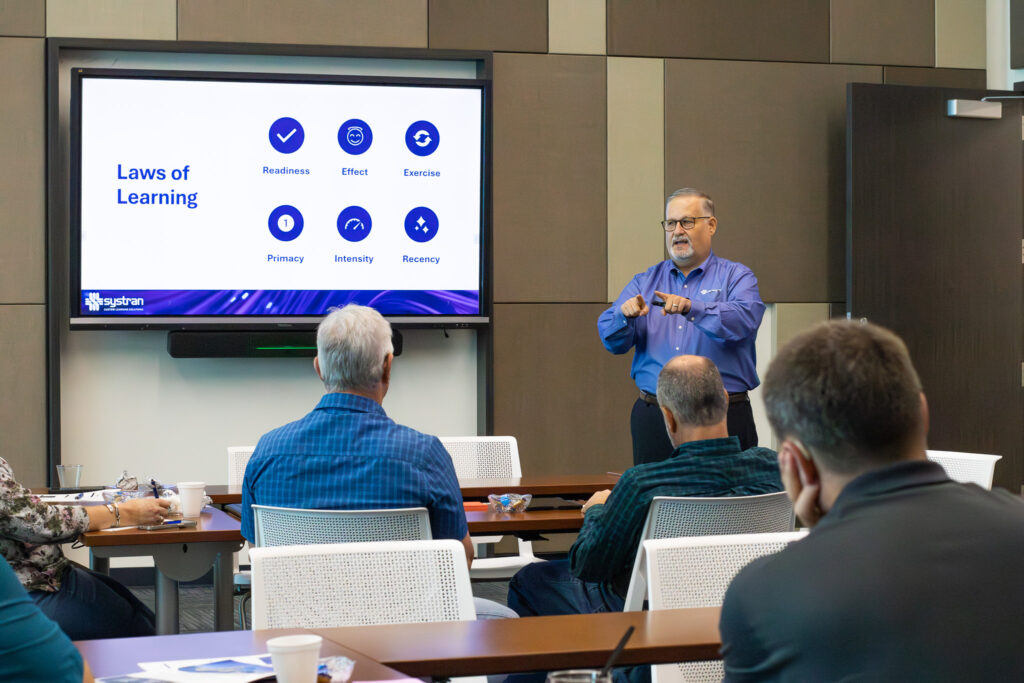Comprehensive courses designed to boost your employees’ training skills, tailored for all learners.
Our courses were developed by industry professionals with decades of experience in learning, human performance, and assessment. We use proven teaching methods that encourage engagement while building each participant’s confidence. Structured supports, group and individual exercises, and frequent reviews aid in retention of critical concepts and skills.


Equips designated trainers with the skills to effectively transfer their knowledge and work experience to new and less experienced team members.

Designed for trainers who are tasked with creating and revising training content and tests, as well as delivering small group and classroom training sessions.

Trains subject matter experts to create effective assessments and develop test questions that accurately measure employee comprehension of critical information.

Designed for trainers, supervisors, and senior team members to determine if employees can successfully perform their job duties. We teach learners about planning an assessment, conducting, and judging the results.
We know each organization is unique. Each of the courses can be customized, to maximize the relevance of the content to your application or need. We will meet with you to understand your requirements and tailor our courses to meet your team’s needs.
Lesson 1: What is a Trainer?
This lesson introduces the role and responsibilities of a trainer, explores how to apply the laws of learning, and discusses knowledge transfer, patterns of learning, mentoring methods, and learning styles.
Lesson 2: Communication Skills
This lesson focuses on the importance of communication skills, covering characteristics of effective communicators and listeners, verbal and non-verbal communication, and how to overcome common barriers to communication.
Lesson 3: Learning Objectives
In this lesson, students learn how to define the scope of learning objectives, write effective learning objectives, and understand how to apply them in a mentoring context.
Lesson 4: Create Mentor Plans
This lesson covers the steps needed to create a training plan, including identifying prerequisites, planning a timeframe, determining resources, defining learning sequence, selecting training methods, and determining assessment methods.
Lesson 5: Practical Application
In this final lesson, students apply the knowledge and skills learned throughout the course by identifying a mentoring task, planning a training session, creating a plan, and demonstrating how to deliver and receive feedback during course evaluation.
Lesson 1: What is a Trainer?
This lesson introduces the role and responsibilities of a trainer, the qualities of an effective trainer, and the principles of adult learning, providing a foundation for effective training methods.
Lesson 2: Communication Skills
This lesson focuses on the importance of communication skills for trainers, covering components of communication, verbal and non-verbal communication, effective listening, and common barriers to communication.
Lesson 3: Create Training
In this lesson, students learn how to create effective training programs using the ADDIE methodology, including needs assessment, objective writing, outline development, and creating assessments.
Lesson 4: Deliver Training
This lesson covers the skills needed to deliver effective training, including creating a positive learning climate, presentation skills, delivering feedback, and managing challenging situations.
Lesson 5: Practical Application
In this final lesson, students apply the knowledge and skills learned throughout the course by creating their own training objectives, outlines, presentations, and assessments, and receiving feedback on their work.
Lesson 1: Course Overview
This lesson introduces the course objectives, explains the purpose of assessment, and distinguishes between knowledge and performance assessments, setting the stage for understanding assessment principles.
Lesson 2: Learning Objectives & Bloom’s Taxonomy
This lesson explores the importance of learning objectives, introduces Bloom’s Taxonomy, and provides guidance on applying learning objectives and Bloom’s levels to create a test question matrix.
Lesson 3: Writing Test Questions
In this lesson, students learn how to write effective test questions, including avoiding trick questions, understanding question types and their strengths and weaknesses, and constructing multiple-choice and matching questions.
Lesson 4: Test Question Review & Validation
This lesson covers the process of reviewing and validating test questions, including working with subject matter experts, performing test question analysis, and ensuring test questions align with learning objectives.
Lesson 5: Practical Application
In this final lesson, students apply the knowledge and skills learned throughout the course by creating a test plan, developing test items, creating a test question matrix, and sharing test examples and feedback.
Lesson 1: What is an Assessor?
This lesson introduces the role and responsibilities of an assessor, the purpose of assessment, and provides an overview of the assessment process, setting the stage for understanding the assessor’s role.
Lesson 2: Principles of Assessment
This lesson explores the principles of assessment, including training objectives, performance criteria, dependability, standardization, and quality assurance, providing a foundation for conducting fair and reliable assessments.
Lesson 3: Assessment Planning
In this lesson, students learn how to create an assessment plan, including planning for real and simulated situations, emergencies, and communication, to ensure a smooth and effective assessment process.
Lesson 4: Conducting an Assessment
This lesson covers the skills needed to conduct an assessment, including pre-assessment activities, communication techniques, observation methods, and documenting evidence, to ensure a fair and reliable assessment process.
Lesson 5: Judging Evidence
In this lesson, students learn how to judge evidence, maintain fairness and consistency, and make informed decisions, as well as how to communicate results and provide effective feedback to candidates.
Lesson 6: Practical Application
In this final lesson, students apply the knowledge and skills learned throughout the course by creating an assessment plan, conducting an assessment, judging evidence, and making an assessment decision, and providing feedback, in a practical and hands-on way.
| Cookie | Duration | Description |
|---|---|---|
| cookielawinfo-checkbox-analytics | 11 months | This cookie is set by GDPR Cookie Consent plugin. The cookie is used to store the user consent for the cookies in the category "Analytics". |
| cookielawinfo-checkbox-functional | 11 months | The cookie is set by GDPR cookie consent to record the user consent for the cookies in the category "Functional". |
| cookielawinfo-checkbox-necessary | 11 months | This cookie is set by GDPR Cookie Consent plugin. The cookies is used to store the user consent for the cookies in the category "Necessary". |
| cookielawinfo-checkbox-others | 11 months | This cookie is set by GDPR Cookie Consent plugin. The cookie is used to store the user consent for the cookies in the category "Other. |
| cookielawinfo-checkbox-performance | 11 months | This cookie is set by GDPR Cookie Consent plugin. The cookie is used to store the user consent for the cookies in the category "Performance". |
| viewed_cookie_policy | 11 months | The cookie is set by the GDPR Cookie Consent plugin and is used to store whether or not user has consented to the use of cookies. It does not store any personal data. |